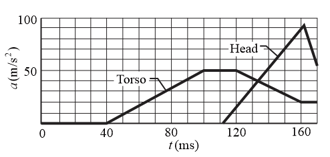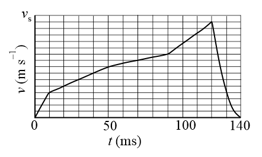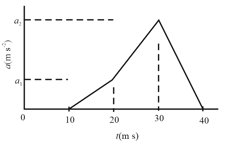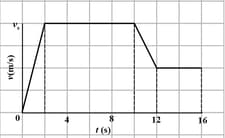A steel ball is dropped from a building's roof and passes a window, taking to fall a distance of from the top to the bottom of the window. It then falls to a sidewalk and bounces back past the window, moving from bottom to top in . Assume that the upward flight is an exact reverse of the fall. The time the ball spends below the bottom of the window is . How tall is the building?

Important Questions on Motion Along a Straight Line
The figure gives the acceleration of a volunteer's head and torso during a rear-end collision. At maximum head acceleration, what is the speed of (a) the head and (b) the torso?

In a forward punch in karate, the fist begins at rest at the waist and is brought rapidly forward until the arm is fully extended. The speed of the fist is given in the figure for someone skilled in karate. The vertical scaling is set by . How far has the fist moved at (a) time and (b) when the speed of the fist is maximum?

When a soccer ball is kicked towards a player he deflects the ball by heading it, the acceleration of the head during the collision can be significant. In the figure gives the measured acceleration of a soccer player's head for a bare head and a helmeted head, starting from rest. The scaling on the vertical axis is set by . At time , what is the difference in the speed acquired by the bare head and the speed acquired by the helmeted head?
A salamander of the genus. Hydromantes captures prey by launching its tongue as a projectile the skeletal part of the tongue is shot forward, unfolding the rest of the tongue, until the outer portion lands on the prey, sticking to it. In the figure shows the acceleration magnitude versus time for the acceleration phase of the launch in a typical situation. The indicated accelerations are and . What is the outward speed of the tongue at the end of the acceleration phase?

How far does the runner whose velocity-time graph, is shown in the figure travel in ? The figure's vertical scaling is set by


